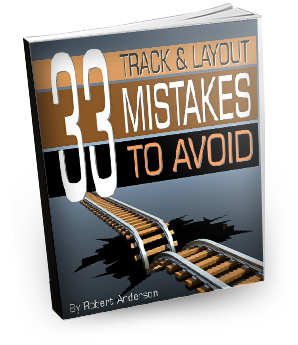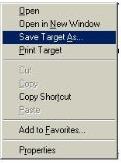|
FREE Report Reveals...
33 Track & Layout Planning
Mistakes To Avoid

Download Your Copy
Here
(instructions for how to download are
below)
Most of us in the model railroading hobby catch the
bug after starting out with a basic circle or oval track configuration. But, after watching the
trains go round… and around… and around a few thousand times, we start to lose interest in what is
a really terrific hobby.
It shouldn’t be like that! And, if you’ve reached
that stage, then it’s time to start planning a more interesting and more functional track layout –
one that will not only keep you interested for hours on end, but also entertain and enthrall
visitors to your model railroad.
It’s time to plan and construct the ultimate model
railroad… the one you always dreamed of having, but didn’t know quite where to start.
Truth is; you’ve probably been flicking through train
magazines, searching the net or visiting model train shows looking for ideas. If that sounds like
you, then you’re ready to progress from being the owner of a toy train set, to a genuine model
railroader. You’re ready to build your “dream model railroad.”
BUT WAIT!!! The “starting off” part is
generally the most crucial stage of the entire process. It’s the point when numerous mistakes can
occur. Fortunately a few of these errors are able to be fixed later and are simply part of the
learning process, but other mistakes during the planning stage will be serious and can pose
continual and longer term problems. They might not only affect the realism of your railroad, but
also affect how smoothly and reliably it operates.
What’s the point in investing time, effort and loads
of money constructing what you imagined was to be the ultimate railroad layout, only to finish up
changing it or beginning over again?
Now, don’t get me wrong; there’s nothing wrong in
making progressive changes for the better and expanding your layout as and when you develop new
skills. That’s what most model railroaders do – their railroad grows as they grow their skills.
That’s very different than always “chasing your tail”, or constantly “putting out fires” due to
poor planning and avoidable mistakes.
Therein lies the problem; if you haven’t been
involved in track planning before how on earth do you know what works and what doesn’t? Ideas for
your dream railroad might look good on paper, but might turn out to be totally impractical when
translated in actual scenery and track.
Model railroading is a vast subject and that’s one of
the things that make it such an interesting hobby. With so many aspects to the hobby, it also means
there’s a lot to learn… and, to progress, you’ll never stop learning. That’s why this free report
focuses on just one area (a very critical area) of the hobby.
This free report won’t focus on selecting and
building a track plan. Instead it focuses on logically thinking about what makes most sense
to best utilize the layout room to give you the most advantage.
Designing workable track plans comes with experience by learning from mistakes you make along the
way, and from the mistakes others have made. Obviously it makes sense to minimize or eliminate your
own errors and to try and avoid expensive mishaps. That’s why learning from others who have walked
the same path can be invaluable.
Why commit to the same frustrating and costly
mistakes others made before you? Repeating the mistakes others have made many times before is not
god use of your resources. So, that’s what this free report is all about. It will hopefully alert
you to potential problems that can be avoided before they happen.
Naturally every layout, every person, and every
situation is different, however most model railroaders encounter similar challenges regardless of
the scale, brand of trains, or operating systems employed. Model railroading problems are not
usually unique to just one person or one railroad. So, there’s no advantage in striving to be the
first to encounter a particular problem, when others have probably already found the
solution.
There is enough to do constructing and operating a
model railroad without wasting valuable time and money patching problems that could have been
avoided in the first place.
Hopefully, with some advance knowledge you will be in
a position to pin point likely planning mistakes or trouble spots well in advance. Do that, and
you’ll have more time running your trains, and doing the model railroading things you most
enjoy.
|
THIS WEBPAGE HAS EVERYTHING YOU NEED
TO GET STARTED. PLEASE READ THIS PAGE
CAREFULLY.
Follow These Easy Steps To
Get Started:
The report is in the
popular PDF format to make downloading quick and
easy. If this is your first time,
don't worry ... it's natural to make mistakes. And it's okay, you can keep on
trying until you get it, alright? I'm here to show you step by
step...
(Read these instructions in full
BEFORE you follow them)
Instructions For
Downloading
|
The file to download is below in the red
box.
Simply
"Right Mouse Click"
on the file and a MENU like the one on the right will open
up.
(MAC users just click the link and
hold down your mouse button)
In
Internet Explorer choose "SAVE TARGET AS"
and download the file to your desktop. (In Netscape and FireFox you
select "SAVE LINK AS")
|

|
Once you select "SAVE TARGET
AS" or "SAVE LINK AS" a download screen will appear
asking where you want to save the file to on your computer.

You can save the file anywhere you
like...BUT, you'll need to remember WHERE you saved it. So choose to
save it to your
"DESKTOP" or in a special folder you created, so that you'll
know where it is.
After you have downloaded the
file, go to your "DESKTOP"
(or the folder you saved it to) and DOUBLE CLICK the file to
open.
The PDF files will automatically open
in Adobe Acrobat Reader and display the report
You can
then print them out.
Download time will vary from computer
to computer depending on your internet speed at the time.
|
|

